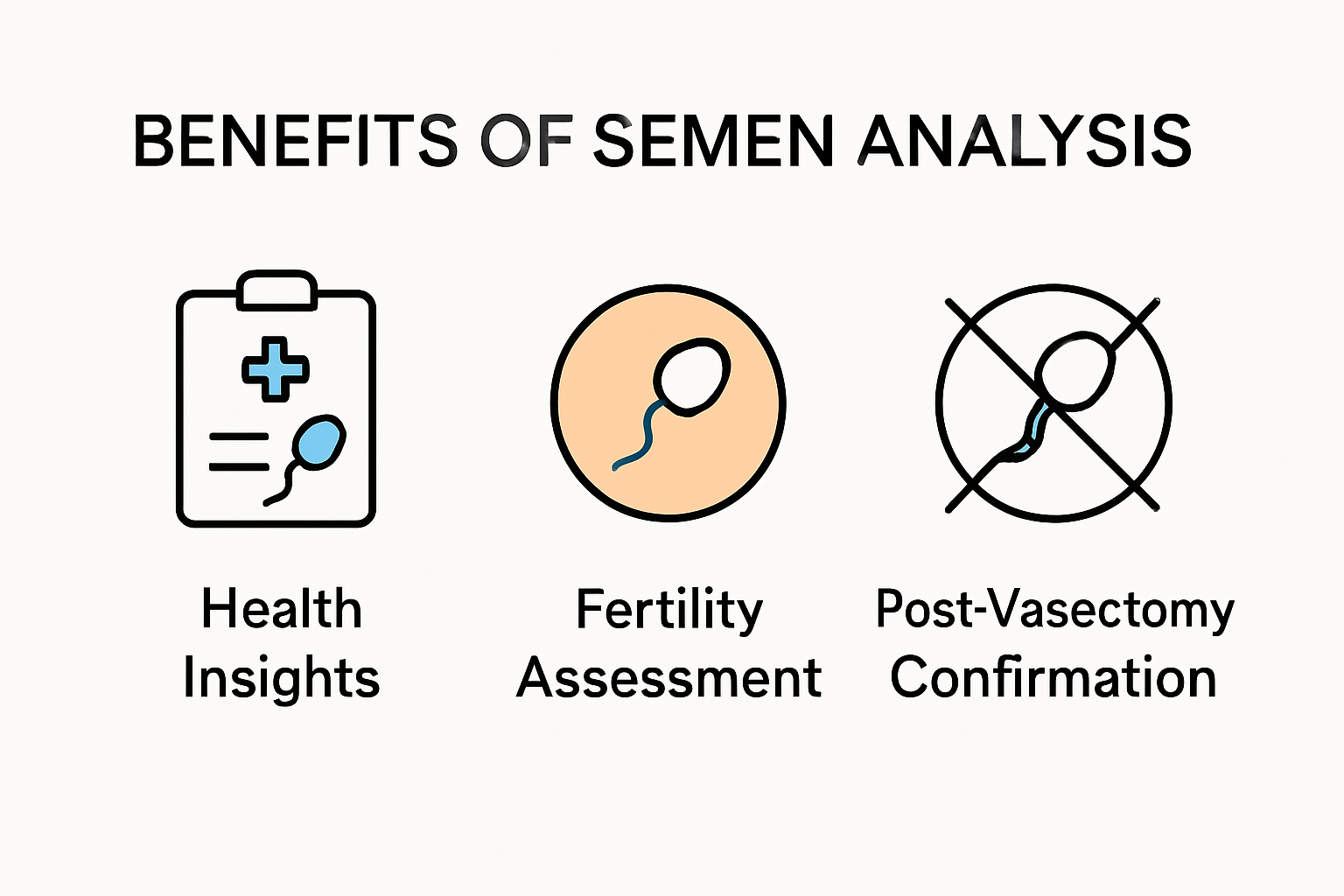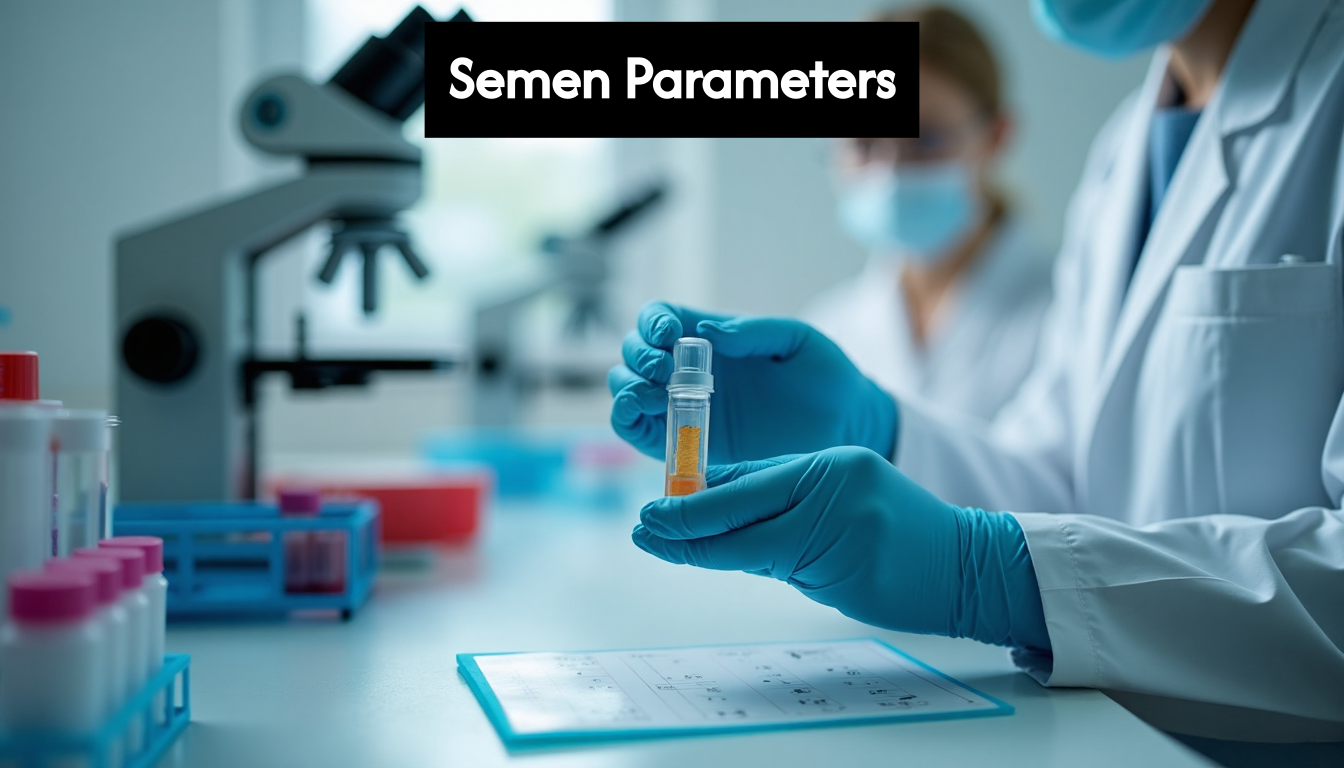Routine semen analysis reveals far more than most people expect. While many assume it is just a quick check after a vasectomy or a basic sperm count for fertility, the reality is far more complex. Male factors are responsible for around 50 percent of all fertility issues and even a single abnormal result can uncover hidden health problems before symptoms ever appear. The biggest surprise? Getting just one test is rarely enough. Several spaced-out analyses give a clearer, more accurate picture of reproductive health and risk. The statistics behind these tests might completely change how you approach family planning or post-vasectomy peace of mind.
Table of Contents
- Understanding Routine Semen Benefits
- Role After Vasectomy: Ensuring Success
- Importance For Couples Trying To Conceive
- How Urologists And Clinics Use Semen Analysis
Quick Summary
| Takeaway | Explanation |
|---|---|
| Routine semen analysis is essential for understanding male reproductive health. | This analysis provides critical insights into sperm parameters that affect fertility, helping to identify potential health issues and guide medical interventions. |
| Post-vasectomy semen analysis is crucial for confirming sterility. | Testing confirms successful vas occlusion and absence of viable sperm, providing peace of mind for couples relying on this method for contraception. |
| Semen analysis plays a key role for couples trying to conceive. | It reveals male fertility potential, helping identify issues early and guiding couples toward effective treatment options and lifestyle modifications. |
| Multiple analyses improve diagnostic accuracy. | Following professional recommendations for several semen tests spaced apart accounts for daily variations, offering a comprehensive view of male reproductive potential. |
| Diagnostic results can indicate underlying health conditions. | Abnormal semen analysis results can highlight systemic or hormonal issues, prompting further medical evaluation and personalized treatment strategies. |

Understanding Routine Semen Benefits
Routine semen analysis provides critical insights into male reproductive health, serving as a powerful diagnostic tool for fertility assessment and post-vasectomy confirmation. Unlike generic medical screenings, this specialized test offers a comprehensive evaluation of sperm parameters that directly impact reproductive potential and family planning strategies.
Key Diagnostic Parameters of Semen Analysis
A comprehensive semen analysis goes far beyond simple sperm counting. According to Cleveland Clinic, the test evaluates multiple critical factors that determine male fertility potential. These parameters include sperm count, motility, morphology, volume, and overall concentration. Sperm count indicates the number of sperm cells present in the sample, while motility measures the percentage of sperm capable of moving effectively. Morphology assesses the shape and structural integrity of sperm, which significantly influences fertilization potential.
Research from Cooper Clinic highlights that abnormalities in these parameters can signal underlying reproductive health challenges. For instance, low sperm count or poor motility might suggest potential fertility restrictions that require further medical investigation. These insights enable proactive medical interventions and personalized treatment strategies.

Post Vasectomy Confirmation and Fertility Monitoring
For men who have undergone vasectomy, routine semen analysis becomes a crucial verification mechanism. American Urological Association Guidelines recommend post-procedure testing to confirm complete vas occlusion and absence of viable sperm. Typically, the first analysis occurs approximately three months after the procedure, allowing sufficient time for residual sperm to clear from the reproductive tract.
Beyond verification, these analyses provide peace of mind and definitive confirmation of contraceptive effectiveness. Couples can confidently transition away from alternative birth control methods once semen analysis confirms successful vasectomy. Moreover, the test helps identify rare instances where surgical sterilization might not have been completely successful, preventing potential unintended pregnancies.
Routine semen analysis benefits extend far beyond simple medical testing. They represent a proactive approach to understanding male reproductive health, offering invaluable insights for family planning, fertility assessment, and post-surgical confirmation. By providing detailed, scientific evaluations of sperm characteristics, these tests empower individuals with comprehensive knowledge about their reproductive potential.
Whether you’re confirming vasectomy success or exploring fertility concerns, our comprehensive guide on semen analysis timing can help you understand the optimal approach for your specific situation. Knowledge is power, especially when it comes to reproductive health.
Role After Vasectomy: Ensuring Success
After undergoing a vasectomy, men enter a critical phase where confirming the procedure’s success becomes paramount. Routine semen analysis plays a pivotal role in verifying sterility and providing peace of mind for individuals and couples seeking reliable contraception.
Understanding Post-Vasectomy Sterility Verification
The journey to confirmed sterility is not instantaneous. According to American Urological Association guidelines, the risk of pregnancy after vasectomy remains approximately 1 in 2,000 for men who have achieved post-vasectomy azoospermia. This statistic underscores the critical importance of systematic follow-up testing. Research indicates that while most men achieve sterility, the process requires careful monitoring and multiple analyses.
Family Medicine research reveals a nuanced picture of post-vasectomy fertility. In a comprehensive systematic review, 80% of patients achieve azoospermia three months after the procedure. However, 1.4% of men continue to have persistent nonmotile sperm, necessitating continued semen analysis until complete sterility is confirmed.
Tracking Sperm Count Progression
A detailed study published in the Urology Journal provides fascinating insights into sperm count progression. Among 4,827 men studied, 58.2% were completely sperm-free on initial post-vasectomy analysis, while 28.3% showed rare nonmotile sperm. Critically, 67.5% of men with initial higher nonmotile sperm counts were downgraded to rare or zero sperm in subsequent tests. This progression highlights why multiple analyses are crucial for confirming vasectomy success.
Men must understand that achieving and confirming sterility is a process, not an immediate outcome. Continued contraception is recommended until semen analysis definitively shows no viable sperm. Learn more about confirming your vasectomy success to navigate this critical period confidently.
The role of routine semen analysis extends beyond mere medical procedure. It represents a proactive approach to reproductive health, offering men scientific confirmation of their contraceptive choice. By systematically tracking sperm count and motility, individuals can transition from surgical intervention to confirmed sterility with precision and confidence.
Remember, patience and thorough testing are key. Each semen analysis brings you closer to the ultimate goal: reliable, verified contraception. Your commitment to follow-up testing ensures not just a successful medical procedure, but peace of mind for you and your partner.
Importance for Couples Trying to Conceive
For couples navigating the complex journey of conception, routine semen analysis emerges as a critical diagnostic tool that provides unprecedented insights into male reproductive health. The profound reality is that male factors contribute to approximately 50% of all fertility challenges, making comprehensive sperm evaluation an essential first step in understanding and addressing potential conception barriers.
Decoding Male Fertility Potential
World Health Organization research emphasizes semen analysis as the cornerstone of investigating male fertility status. The analysis goes beyond simple sperm counting, offering a multi-dimensional assessment of reproductive potential. Key parameters such as sperm concentration, motility, morphology, and overall functional capacity provide couples with actionable medical insights.
According to National Center for Biotechnology Information studies, male-factor infertility is not just a statistical concern but a complex interplay of biological factors. Semen analysis can reveal subtle abnormalities that might otherwise go undetected, allowing couples to pursue targeted interventions and personalized fertility strategies.
Early Detection and Intervention
Houston Methodist Medical Research highlights that semen analysis is more than a fertility diagnostic tool. Abnormal results can signal underlying health conditions, providing an early warning system for potential reproductive and systemic health issues. From hormonal imbalances to potential genetic factors, these comprehensive tests offer a window into overall male reproductive health.
For couples trying to conceive, understanding these nuanced details can transform their approach from reactive to proactive. Each semen analysis result provides a roadmap for potential medical interventions, lifestyle modifications, or specialized fertility treatments. Explore comprehensive sperm function testing to gain deeper insights into your reproductive potential.
The emotional and financial investment in fertility journey demands comprehensive, scientifically rigorous approaches. Routine semen analysis empowers couples with knowledge, reducing uncertainty and providing a clear, data-driven perspective on their conception possibilities. By embracing these advanced diagnostic tools, couples can make informed decisions, potentially accelerating their path to successful pregnancy.
Remember, fertility is a shared journey. While these tests focus on male reproductive parameters, they represent a collaborative approach to understanding and overcoming conception challenges. Each test is a step towards understanding, healing, and ultimately, creating the family you dream of.
How Urologists and Clinics Use Semen Analysis
Urologists and clinics employ semen analysis as a sophisticated diagnostic and monitoring tool that provides comprehensive insights into male reproductive health. This specialized medical procedure serves multiple critical functions, ranging from fertility assessment to post-surgical verification, making it an indispensable component of modern reproductive healthcare.
Diagnostic Protocol and Evaluation Strategies
According to Healthline Medical Research, professional medical protocols typically involve conducting multiple semen analyses to ensure accurate results. Urologists often recommend two or three separate analyses spaced at least seven days apart over two to three months. This strategic approach accounts for daily variations in sperm parameters and provides a more comprehensive understanding of male reproductive potential.
American Urological Association Guidelines emphasize the importance of systematic testing, particularly in post-vasectomy scenarios. Clinicians require precise documentation of vas occlusion, mandating continued contraception until semen analysis definitively confirms the absence of viable sperm. This meticulous approach ensures patient safety and contraceptive reliability.
Post-Procedure and Fertility Assessment Protocols
Cooper Clinic Research reveals that urologists approach semen analysis with a multifaceted methodology. For vasectomy confirmation, the first analysis is typically recommended three months post-procedure, allowing sufficient time for residual sperm to clear from the reproductive tract. In fertility investigations, clinicians analyze multiple parameters including sperm count, motility, morphology, volume, and concentration to provide a comprehensive reproductive health assessment.
The analysis goes beyond mere numbers. Explore comprehensive insights into semen analysis testing to understand the intricate details clinicians evaluate. Professional interpretation of these results can reveal underlying health conditions, potential genetic factors, and specific interventions that might enhance reproductive outcomes.
Urologists recognize that semen analysis is more than a technical procedure. It represents a critical communication tool between healthcare providers and patients. Each analysis provides a snapshot of reproductive health, offering opportunities for personalized medical guidance, lifestyle recommendations, and targeted interventions.
The evolving landscape of reproductive medicine continues to refine these diagnostic approaches. Modern clinics are increasingly adopting comprehensive, patient-centered methodologies that view semen analysis not just as a test, but as a comprehensive health assessment tool. By combining advanced scientific techniques with compassionate patient care, urologists transform these analyses from simple medical procedures into powerful instruments of reproductive health understanding.
Ultimately, semen analysis in clinical settings represents a convergence of medical expertise, technological precision, and patient-focused care. It empowers individuals with scientifically validated insights into their reproductive potential, bridging the gap between medical complexity and personal reproductive journeys.
Frequently Asked Questions
What is routine semen analysis and its purpose?
Routine semen analysis is a diagnostic test that evaluates multiple parameters of sperm, including sperm count, motility, and morphology. It serves to assess male reproductive health, confirm vasectomy success, and identify potential fertility issues.
How soon after a vasectomy should I get a semen analysis?
Typically, it is recommended to wait about three months after a vasectomy before undergoing a semen analysis. This allows sufficient time for any residual sperm to clear from the reproductive tract and provides a more accurate assessment of sterility.
Why do multiple semen analyses provide better results?
Multiple semen analyses help account for daily variations in sperm parameters. Conducting several tests spaced apart ensures a more comprehensive view of reproductive health and increases diagnostic accuracy, leading to better-informed medical decisions.
How does semen analysis help couples trying to conceive?
Semen analysis offers crucial insights into male fertility potential by revealing key parameters that may affect a couple’s ability to conceive. Early detection of abnormalities allows for timely medical intervention and personalized treatment strategies.
Take Charge of Your Fertility From Home—No Clinic Visits Needed
Struggling with the stress of repeated lab appointments, or feeling anxious about waiting for clear confirmation after your vasectomy? This article explains why routine semen analysis is vital not only for confirming sterility but also for gaining insights into male fertility health. Many couples and individuals are overwhelmed by the uncertainty of single test results, daily sperm count variations, and the complicated process often required to access reliable care. You deserve answers that are private, convenient, and accurate—on your own schedule.





